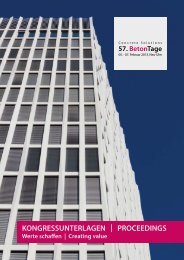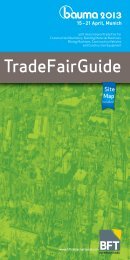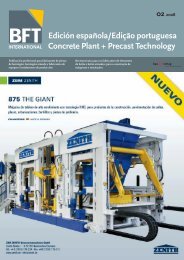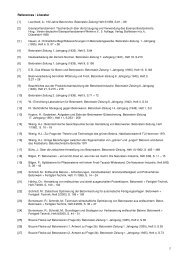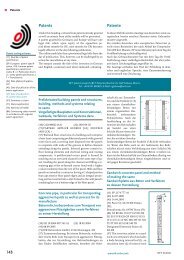Tagungsband - BFT International
Tagungsband - BFT International
Tagungsband - BFT International
Erfolgreiche ePaper selbst erstellen
Machen Sie aus Ihren PDF Publikationen ein blätterbares Flipbook mit unserer einzigartigen Google optimierten e-Paper Software.
PANEL 8 // PROCEEDINGS<br />
� Most manufacturers of concrete products<br />
and precast elements order mineral aggregates<br />
in accordance with DIN 12620 (or DIN 4226 on<br />
the basis of some old supply agreements)<br />
without thinking of what this actually means.<br />
DIN 12620 specifies several classes of aggre-<br />
gates but not all of them are suitable for pro-<br />
ducing concrete in accordance with DIN EN<br />
206-1 or DIN 1045-2. The reference to DIN<br />
12620 does not suffice for defining the required<br />
classes of properties.<br />
AGREED STANDARD REQUIREMENTS Yet the<br />
procurement of mineral aggregates in ac-<br />
cordance with DIN 12610, in conjunction with<br />
standard requirements specified in DIN 1045-2,<br />
Annex U, only means that the concrete produ-<br />
ced will safely meet its load-bearing parame-<br />
ters and the usual durability specifications. No<br />
requirements as to its appearance and visual<br />
appeal are considered.<br />
AUTHOR //<br />
AUTOR<br />
DAMAGE CASE: COAL IN CONCRETE PAVERS AND PRECAST ELEMENTS<br />
– A DEFECT DESPITECOMPLIANCE WITH THE STANDARD?<br />
SCHADENSFALL: KOHLE IN PFLASTERSTEINEN UND FERTIGTEILEN –<br />
MANGEL TROTZ EINHALTUNG DER NORM?<br />
� FIG. 1 Accumulation<br />
of coal particles. //<br />
ABB. 1 Ansammlung von<br />
Kohlepartikeln.<br />
Dr.-Ing: Jürgen Krell,<br />
krell-consult, Hilden<br />
info@krell-consult.de<br />
Nach jeweils elf Jahren in der Zementindustrie (VDZ)<br />
und der Betonindustrie (Readymix, heute CEMEX)<br />
seit mehr als acht Jahren eigenes Ingenieurbüro,<br />
gleichzeitig weiterhin in nationalen und internatio-<br />
nalen Gremien tätig; ö. b. u. v. Sachverständiger<br />
140 <strong>BFT</strong> 02/2011 www.bft-online.info<br />
� Die meisten Betonhersteller bestellen Gesteins-<br />
körnung nach DIN 12620 (zum Teil in Altverträgen<br />
nach DIN 4226), ohne sich Gedanken darüber zu<br />
machen, was das bedeutet. In der DIN 12620 wer-<br />
den verschiedene Gesteinskörnungsklassen auf-<br />
geführt, die nicht alle für die Herstellung von<br />
Beton nach DIN EN 206-1 bzw. DIN 1045-2 geeig-<br />
net sind. Der Verweis auf die DIN 12620 ist nicht<br />
hinreichend, um die erforderlichen Eigenschafts-<br />
klassen zu definieren.<br />
REGELANFORDERUNGEN VEREINBART Aber auch<br />
die Bestellung von Gestein nach DIN 12610 mit<br />
Regelanforderungen nach DIN 1045-2 Anhang U<br />
bedeutet nur, dass der damit hergestellte Beton<br />
seine Tragwirkung sowie die übliche Dauerhaftig-<br />
keit sicher erfüllt, es sind keinerlei Anforderungen<br />
optischer Art berücksichtigt.<br />
Die Einhaltung der Regelanforderungen bedeutet,<br />
dass z. B. im Sand bis 4 mm 0,5 M-% leichtgewich-<br />
tige organische Verunreinigungen zulässig sind.<br />
Für einen Vorsatzbeton mit 1400 kg/m³ Sand dür-<br />
fen das im Beton bis z. B. 7 kg/m³ Holzkohle sein.<br />
Diese können bereits eine deutlich sichtbare Be-<br />
einträchtigung der Pflastersteinoberfläche darstellen.<br />
ABB. 1 deutet auf ca. 2-3 kg Kohle je Kubikmeter<br />
Beton hin, also weit unter Regelanforderungen.<br />
Compliance with the standard requirements<br />
means that, for instance, sand in sizes of up<br />
to 4 mm may contain 0.5 wt.-% of lightweight<br />
organic contaminations. In a face mix with<br />
1,400 kg/m³ of sand, the concrete may conta-<br />
in up to 7 kg/m³ of charcoal. Even these con-<br />
taminations may have a clearly visible delete-<br />
rious effect on the paver surface. FIG. 1<br />
suggests approx. 2 to 3 kg of coal per cubic<br />
meter of concrete, i.e. significantly below the<br />
standard requirements.<br />
Disputes often go both ways, i.e. the customer<br />
is reproached because it considers the coal<br />
accumulation a defect, but also the aggregates<br />
supplier, which usually refers to the contrac-<br />
tually agreed delivery (i.e. free from defects).<br />
At the same time, discussions arise for pre-<br />
fabricated architectural concrete components<br />
where some concrete constituents cause dis-<br />
colorations, such as pyrite (FIG. 2). The standard<br />
requirements specified in DIN 12620 permit a<br />
certain portion of these constituents.<br />
SPECIFIC SURFACE QUALITY OF THE CONCRETE<br />
The DIN EN 12620 standard pertaining to mi-<br />
neral aggregates also contains Annex G that<br />
was added for information purposes and re-<br />
commends additional specifications to be<br />
agreed upon with respect to the surface qua-<br />
lity of the concrete. These include reductions<br />
in the ratio of “lightweight organic contamina-<br />
tions”, which include coal-like constituents,<br />
and agreements on the maximum ratio of co-<br />
loring constituents.<br />
If there is no evidence of such additional ag-<br />
reements, the discussion with the aggregates<br />
supplier, which makes reference to the con-<br />
tractually agreed delivery of mineral aggre-<br />
gates in accordance with standard require-<br />
ments, will be unsuccessful.<br />
GUIDANCE FOR END CLIENTS For this reason,<br />
many concrete product and precast element<br />
manufacturers include a provision in their Ge-<br />
neral Terms and Conditions indicating that<br />
stains may occur that do not constitute a de-<br />
fect in accordance with the GT&C statement.



